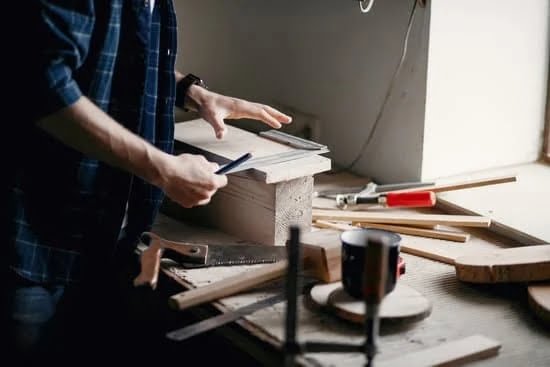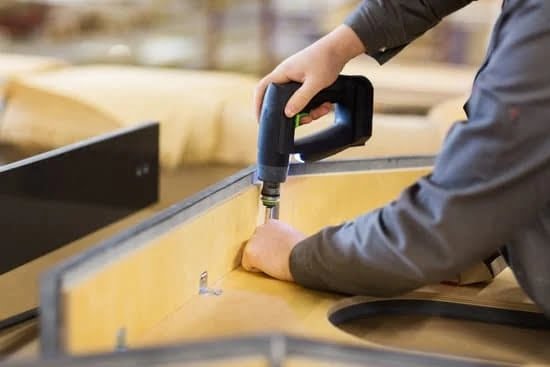Are you interested in learning how to draft a woodworking project? Proper planning is crucial when it comes to woodworking, as it can make the difference between a successful project and a disappointing one. From choosing the right materials to adding the finishing touches, each step requires careful consideration and attention to detail.
One of the first steps in drafting a woodworking project is understanding the different types of wood and their uses. This knowledge will not only help you choose the right materials for your project but will also ensure that your final product is sturdy and long-lasting. Taking accurate measurements is another important aspect of drafting, as precision is key in woodworking. Using the right tools and techniques will help you achieve precise results.
Once you have chosen your materials and taken accurate measurements, it’s time to draft the design. Creating a detailed blueprint will serve as your guide throughout the entire project. In this introductory section, we will explore the importance of proper planning in woodworking projects, providing tips and techniques for each stage of the process. Whether you’re a beginner or an experienced woodworker, these guidelines will help you create successful projects with professional results.
Choosing the Right Materials
When it comes to woodworking, choosing the right materials is crucial in ensuring the success of your project. Understanding the different types of wood and their uses is essential for creating a sturdy and visually appealing finished product.
Wood Types and Their Characteristics
Each type of wood has its own unique characteristics that make it suitable for specific applications. For example, hardwoods like oak, maple, and cherry are known for their strength and durability, making them ideal for furniture and cabinets. Softwoods such as pine and cedar, on the other hand, are commonly used for construction and outdoor projects due to their natural resistance to decay and insects.
Considerations When Choosing Wood
In addition to understanding the characteristics of different wood types, it’s important to consider factors such as grain pattern, color variations, and cost when selecting materials for your woodworking project. Some projects may benefit from the visual appeal of a certain type of wood, while others may require a more affordable or readily available option.
Working With Reclaimed Wood
For those interested in sustainability or a rustic aesthetic, reclaimed wood can be an excellent choice for woodworking projects. However, working with reclaimed wood presents unique challenges including removing nails or screws, dealing with irregular shapes, and addressing potential damage from previous use. Understanding how to properly handle reclaimed wood is essential in achieving successful results.
By taking the time to understand the characteristics of different wood types and considering various factors when choosing materials for your woodworking project, you can ensure that your finished product not only looks great but also performs well.
Taking Accurate Measurements
Accurate measurements are crucial in woodworking projects to ensure that the final product is well-constructed and visually appealing. The following are essential tools necessary when taking measurements:
- Tape Measure: A flexible tape measure is a standard tool for taking linear measurements. It’s important to choose one that can lock in place securely to prevent the tape from moving while recording measurements.
- Combination Square: This versatile tool allows for precise measurements, marking 90-degree angles, and checking for squareness of components.
- Calipers: Used for measuring small dimensions, calipers provide accurate readings in both internal and external dimensions.
When using these tools, it’s important to pay attention to detail and take multiple measurements to confirm accuracy. Additionally, when measuring wood pieces, make sure to measure from multiple reference points such as edges or corners to ensure consistency throughout the project.
Furthermore, there are specific techniques that can help achieve precision when taking measurements. When measuring large surfaces, it’s helpful to use a story stick – a piece of wood marked with all necessary dimensions – allowing you to transfer measurements accurately without constantly re-measuring. Additionally, when measuring irregular shapes or curves, flexible measuring tapes or contour gauges can be useful. Overall, taking accurate measurements lays the groundwork for a successful woodworking project by ensuring that all components fit together seamlessly.
Drafting the Design
When it comes to woodworking projects, drafting the design is a crucial step in ensuring the success of your endeavor. A detailed blueprint not only serves as a guide for the build but also helps anticipate any potential challenges and allows for necessary adjustments before construction begins. Here are some tips on how to draft a woodworking project.
First and foremost, it’s essential to have a clear vision of what you want to achieve with your woodworking project. Whether it’s a piece of furniture, a decorative item, or a functional structure, sketching out the design on paper can help solidify your ideas and serve as a reference throughout the drafting process. Consider the dimensions, proportions, and overall aesthetic that you want to achieve.
Once you have a rough sketch of your woodworking project, it’s time to create a detailed blueprint. This involves accurately measuring all components of the design and transferring them onto graph paper or using digital drafting software. Whether you choose traditional or digital methods, precision is key in this stage, as any inaccuracies can lead to flawed execution during the building phase.
In addition to measurements, be sure to include annotations and notes on your blueprint. These should cover details such as material specifications, joinery techniques, hardware requirements, and any other relevant information that will be crucial during construction. The more comprehensive your blueprint is, the smoother your woodworking project will proceed.
Incorporating Joinery Techniques
Joinery techniques are an essential aspect of woodworking projects, as they determine the strength and overall aesthetic appeal of the finished piece. There are numerous ways to join wood pieces together, each with its unique advantages and applications. Understanding these different techniques is crucial in ensuring the stability and longevity of your woodworking project.
Types of Joinery Techniques
One of the most common joinery methods is the use of dovetail joints, known for their interlocking design that provides exceptional strength. Another popular technique is the mortise and tenon joint, which involves a protruding tenon on one piece fitting into a corresponding mortise on another. Additionally, biscuit joints, dowel joints, and pocket hole screws are also widely used in woodworking for their ease of implementation and reliable results.
Considerations for Choosing Joinery Techniques
When deciding on which joinery technique to use for your woodworking project, it’s important to consider factors such as the type of wood being used, the intended purpose of the piece, and your skill level as a woodworker. For instance, certain woods may be better suited for specific joinery methods due to their density or grain pattern.
Moreover, if your project will undergo heavy loads or stress, you’ll want to opt for stronger joint options such as through-tenons or half-lap joints.
Tips for Incorporating Joinery Techniques
Before finalizing your woodworking project plans, it’s advisable to create prototypes or mock-ups to test out different joinery techniques. This allows you to assess their structural integrity and visual appeal before committing to the final build.
Additionally, investing in high-quality tools specifically designed for joinery work can greatly enhance the precision and reliability of your wood connections. As you draft your woodworking project plans, take time to research and practice various joinery methods to determine which best suits your design and construction needs.
By thoroughly exploring different ways to connect wood pieces through various joinery techniques in your planning process, you can ensure that your woodworking project will not only be visually appealing but also structurally sound and durable.
The Importance of Prototyping
Before you start the final build of your woodworking project, it is crucial to create a prototype to test your design. This step allows you to identify any potential issues or flaws before investing time and money into the actual construction. Here are some key points on how to effectively prototype your woodworking project:
- Use inexpensive materials: When creating a prototype, it’s best to use cheaper materials that can easily be manipulated and modified. This allows you to make adjustments without incurring significant costs.
- Focus on functionality: The primary goal of prototyping is to assess the functionality of your design. Test how well the pieces fit together, evaluate the structural integrity, and ensure that the dimensions are accurate.
- Solicit feedback: It’s beneficial to seek input from others during the prototyping phase. This can provide fresh perspectives and ideas for improvement, ultimately leading to a better end result.
By incorporating prototyping into your woodworking process, you can avoid potential setbacks and enhance the quality of your final build.
Remember that prototyping is an essential part of the woodworking project planning process. It not only helps you identify and address any flaws in your design but also gives you an opportunity to experiment with different approaches and materials before committing to the final build. Take the time to create a prototype and use it as a valuable tool for refining your woodworking project plans.
In summary, prototyping plays a critical role in ensuring the success of your woodworking project. It allows you to test and refine your design, gather valuable feedback, and make necessary adjustments before moving forward with the final construction phase. Embrace prototyping as an integral part of the planning process, and it will undoubtedly contribute to the overall success of your woodworking endeavors.
Adding Finishing Touches
Once the woodworking project is complete, adding the finishing touches is crucial to achieving a professional and polished final product. Sanding is an essential step in creating a smooth surface and removing any imperfections in the wood. There are different grits of sandpaper available, each serving a specific purpose in the sanding process. For example, coarse grits are used for heavy material removal, while finer grits are ideal for achieving a smooth finish.
After sanding, staining the wood can enhance its natural beauty and add color to the finished piece. It’s important to choose the right type of stain based on the wood species and desired end result. Additionally, applying a sealant after staining not only protects the wood from moisture and wear but also adds a professional touch to the project.
Lastly, before considering your woodworking project complete, it’s crucial to review every aspect of the design and make any necessary revisions. This is often an overlooked step but can prevent potential issues during the building process. This includes examining measurements, materials used, joinery techniques incorporated, and overall design cohesiveness.
| Woodworking Finishing | Data |
|---|---|
| Sanding Grits | Coarse grits for heavy material removal; finer grits for smooth finish |
| Staining and Sealing | Choose the right stain based on wood species; apply sealant for protection and professional look |
| Carefully examine all aspects of the design; make necessary revisions to avoid future issues |
Finalizing the Draft
After spending time carefully choosing materials, taking accurate measurements, drafting the design, and incorporating joinery techniques, it’s crucial to finalize the draft of your woodworking project plan by reviewing and revising it. This step is often overlooked but can make a significant difference in the outcome of your project.
To begin finalizing your draft, start by reviewing the entire plan from start to finish. Look for any inconsistencies, inaccuracies, or potential pitfalls that may have been missed during the initial drafting process. Pay close attention to measurements, joinery techniques, and material choices.
Once you have thoroughly reviewed your woodworking project plans, it’s time to revise them as needed. This may involve making adjustments to the design, altering joinery techniques, or re-evaluating material choices. Keep in mind that revisions are a normal part of the woodworking process and can ultimately lead to a better end result. Don’t be afraid to seek feedback from other woodworkers or professionals if you’re unsure about certain aspects of your plan.
Remember that finalizing the draft of your woodworking project plans is an essential step in ensuring a successful build. By carefully reviewing and revising your plans, you can catch any potential issues before they arise and make necessary adjustments for a smoother construction process.
Conclusion
In conclusion, the process of drafting a woodworking project is an essential step in ensuring a successful and satisfying outcome. By following the guidelines outlined in this article, woodworkers can effectively plan and prepare for their projects with confidence.
Understanding the importance of proper planning, choosing the right materials, taking accurate measurements, and utilizing appropriate joinery techniques are all crucial aspects of creating a detailed and reliable blueprint for a woodworking project. Additionally, the incorporation of prototyping allows for testing and refining designs before the final build, while adding finishing touches such as sanding, staining, and sealing contribute to a professional look.
By emphasizing the value of thorough planning in woodworking, individuals can potentially avoid costly mistakes and wasted materials by carefully reviewing and revising their plans before moving forward with construction. This not only leads to a more efficient building process but also ensures a higher quality end result.
In sum, learning how to draft a woodworking project involves dedicating time and attention to each step of the planning process. With diligent effort put into every detail from start to finish, woodworkers can pave the way for successful execution of their projects.
Frequently Asked Questions
What Woodworking Project Is Most Profitable?
The most profitable woodworking projects are typically those that are in high demand and can be customized to the specific needs and preferences of customers. Examples include custom furniture pieces, kitchen cabinets, outdoor furniture, and decorative wooden items.
These projects often require a higher level of skill and precision, but they also offer a greater potential for profit due to their customization and craftsmanship.
What Is a Plan of Procedure in Woodworking?
A plan of procedure in woodworking is essentially a blueprint or set of instructions that outlines the steps necessary to complete a woodworking project. This plan includes details such as measurements, materials needed, tools required, assembly instructions, and finishing techniques. Having a well-organized plan of procedure is essential for ensuring that the project is completed accurately and efficiently.
What Are the Basic Steps of Woodworking?
The basic steps of woodworking typically include planning and design, measuring and cutting the wood pieces, assembling the parts together using joinery techniques like gluing or fastening with screws or nails, sanding the surfaces for smoothness, applying finishes such as paint or stain, and finally, adding any additional decorative elements if desired.
Each step requires careful attention to detail and precision to achieve a high-quality finished product.

Hi everyone! I’m a woodworker and blogger, and this is my woodworking blog. In my blog, I share tips and tricks for woodworkers of all skill levels, as well as project ideas that you can try yourself.





